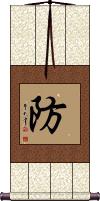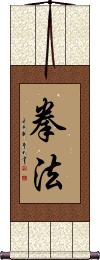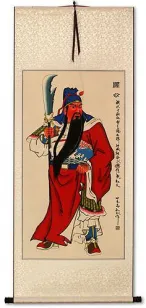Many custom options...
And formats...

Defense Defend in Chinese / Japanese...
Buy a Defense Defend calligraphy wall scroll here!
Personalize your custom “Defense Defend” project by clicking the button next to your favorite “Defense Defend” title below...
Defense / Defend
防 is a single Chinese character and Korean Hanja that means to protect, defend, guard against, prevent, ward off, or counter.
防 means the same thing in Japanese, though seldom seen alone as a single Kanji. When written alone, it could be the Japanese surname Fusegi.
Kenpo / Kempo / Quan Fa / Chuan Fa
拳法 is a form of martial arts that can be translated in several ways.
Some will call it “fist principles,” “the way of the fist,” or even “law of the fist.” The first character literally means fist. The second can mean law, method, way, principle, or Buddhist teaching.
Kempo is really a potluck of martial arts. Often a combination of Chinese martial arts such as Shaolin Kung Fu with Japanese martial arts such as Karate, Jujutsu (Jujitsu), Aikido, and others. You may see the term “Kempo Karate,” which basically means Karate with other disciplines added. In this way, Kempo becomes an adjective rather than a title or school of martial arts.
These facts will long be argued by various masters and students of Kempo. Even the argument as to whether it should be spelled “kenpo” or “Kempo” ensues at dojos around the world (the correct Romaji should actually be “kenpou” if you precisely follow the rules).
The benefit of Kempo is that the techniques are easier to learn and master than pure Kung Fu (wu shu). Students are often taught basic Karate moves, kicks, and punches before augmenting the basic skills with complex Kung Fu techniques. This allows students of Kempo to achieve a level where they can defend themselves or fight in a relatively short amount of time (a few years rather than a decade or more).
Because the definition of this word is so fluid, I should make some notes here:
1. Purists in Okinawa will claim that “Okinawa Kenpo” or “Ryukyu Hon Kenpo” is the original and true version of this martial art from the old kingdom. It is actually little or no connection between Okinawa Kenpo and the way the word is used elsewhere.
2. In Chinese, where these characters are pronounced “quan fa” (sometimes Romanized as “chuan fa” because the Chinese-pinyin “q” actually sounds like an English “ch” sound), these characters do not hold the connotation of being a mixed martial art. It is simply defined as “the law of the fist.”
3. My Japanese dictionary oddly defines Kenpo as the “Chinese art of self-defense.” I personally don't feel this is the most common way that people perceive the word but just something you should know.
This in-stock artwork might be what you are looking for, and ships right away...
Not the results for Defense Defend that you were looking for?
Below are some entries from our dictionary that may match your Defense Defend search...
| Characters If shown, 2nd row is Simp. Chinese |
Pronunciation Romanization |
Simple Dictionary Definition |
自衛 自卫 see styles |
zì wèi zi4 wei4 tzu wei jiei / jie じえい |
More info & calligraphy: Self-Defense(n,vs,vt,vi,adj-no) self-defense; self-defence |
保衛 保卫 see styles |
bǎo wèi bao3 wei4 pao wei yasue やすえ |
to defend; to safeguard (noun/participle) defense; defence; protection; safeguard; (given name) Yasue |
攻防 see styles |
gōng fáng gong1 fang2 kung fang koubou / kobo こうぼう |
to attack and defend (usu. in reference to opposing sides, but can be one party playing both roles) offense and defense; offence and defence |
自保 see styles |
zì bǎo zi4 bao3 tzu pao |
to defend oneself; self-defense; self-preservation |
辯解 辩解 see styles |
biàn jiě bian4 jie3 pien chieh benkai べんかい |
to explain; to justify; to defend (a point of view etc); to provide an explanation; to try to defend oneself (out-dated kanji) (n,vs,adj-no) justification; rationalization; pretext; explanation; exculpation; defence; defense; excuse; apology |
辯護 辩护 see styles |
biàn hù bian4 hu4 pien hu |
to speak in defense of; to argue in favor of; to defend; to plead |
防禦 防御 see styles |
fáng yù fang2 yu4 fang yü bougyo / bogyo ぼうぎょ |
defense; to defend (n,vs,adj-no) defense; defence; safeguard; protection |
防衛 防卫 see styles |
fáng wèi fang2 wei4 fang wei bouei / boe ぼうえい |
to defend; defensive; defense (noun, transitive verb) defense; defence; protection |
保家衛國 保家卫国 see styles |
bǎo jiā wèi guó bao3 jia1 wei4 guo2 pao chia wei kuo |
guard home, defend the country (idiom); national defense |
自衛手段 see styles |
jieishudan / jieshudan じえいしゅだん |
(noun/participle) measures to defend oneself (for self-defense) (defence) |
The following table may be helpful for those studying Chinese or Japanese...
| Title | Characters | Romaji (Romanized Japanese) | Various forms of Romanized Chinese | |
| Defense Defend | 防 | bou / bo | fáng / fang2 / fang | |
| Kenpo Kempo Quan Fa Chuan Fa | 拳法 | kenpou / kenpo | quán fǎ / quan2 fa3 / quan fa / quanfa | ch`üan fa / chüanfa / chüan fa |
Successful Chinese Character and Japanese Kanji calligraphy searches within the last few hours...






